Trending
Opinion: How will Project 2025 impact game developers?
The Heritage Foundation's manifesto for the possible next administration could do great harm to many, including large portions of the game development community.

Featured Blog | This community-written post highlights the best of what the game industry has to offer. Read more like it on the Game Developer Blogs or learn how to Submit Your Own Blog Post
I'm working on a new website called GameDataCrunch.com, a new way to understand the game industry by looking at metrics and slicing them up in a bunch of different ways.

I'm working on a new website called GameDataCrunch.com, a new way to understand the game industry by looking at metrics and slicing them up in a bunch of different ways.
If you want to check it out right now just go to GameDataCrunch.com.
If you want to understand my underlying design philosophy for the site, read on.
Here's one view:
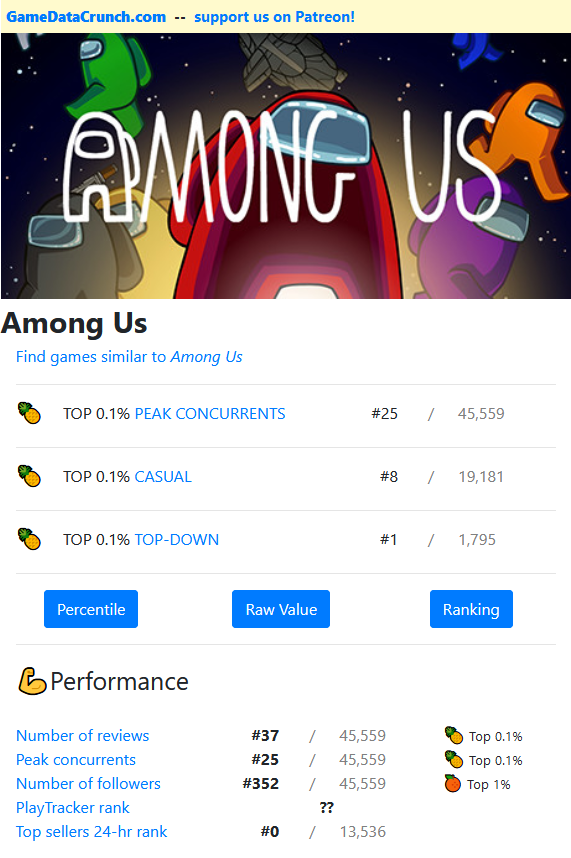
Here's another:
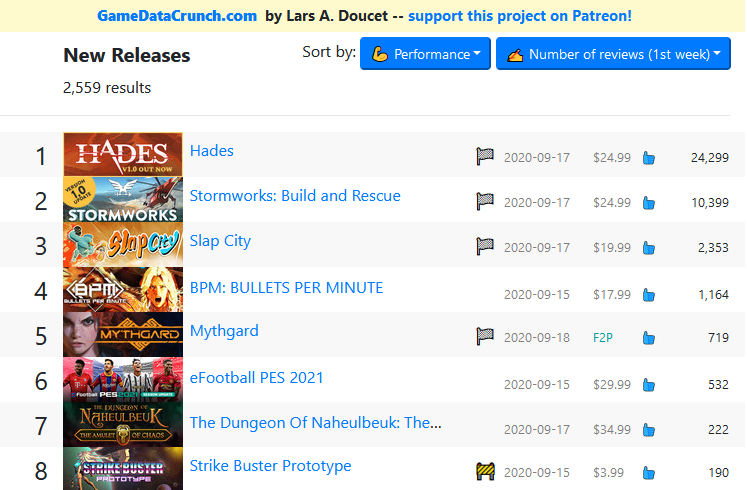
But, let's start at the beginning. Let's pick a game, say DOOM (2016). We'll just type DOOM into the search box and click:
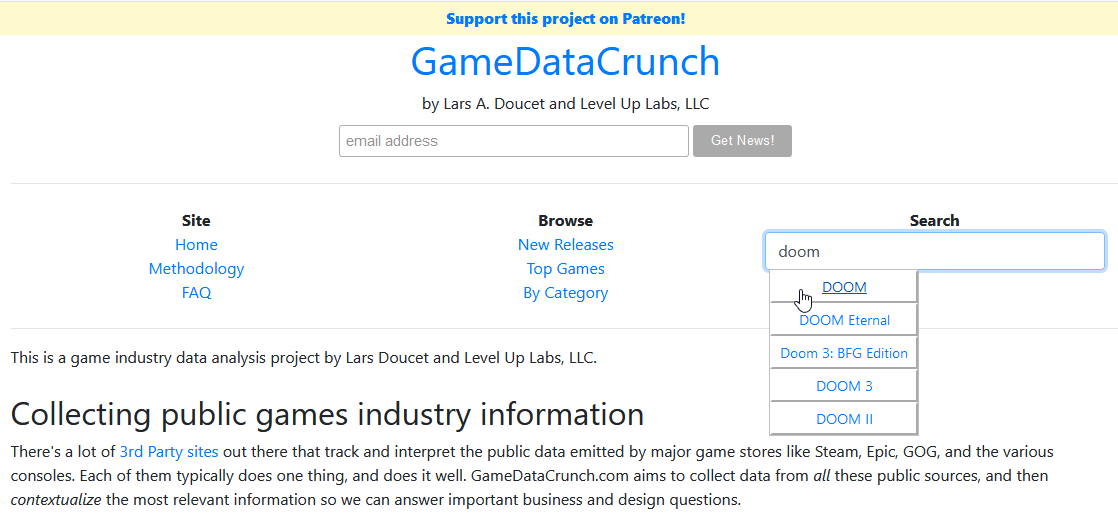
That takes us to the detail page for Doom.
The top of the page has a link to similar games and a hilighted summary of some of the game's best performing metrics.
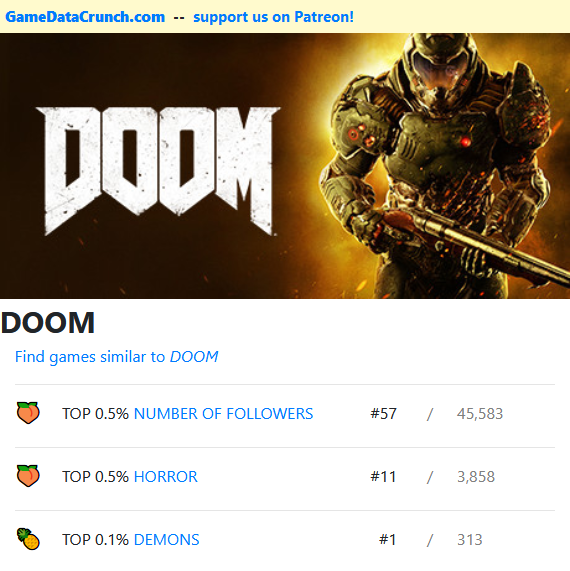
We can see that it's a in the top 0.5% of games in terms of number of followers, and furthermore that it's a top-tier Horror game. Impressively, it's the #1 game with the "Demons" tag, though we can tell from the rank totals that there's less then 10% as many of those as there are Horror games.
Clicking on any of the links will take you a view that shows those rankings in a list. But before we hop over there, let's keep scrolling down:
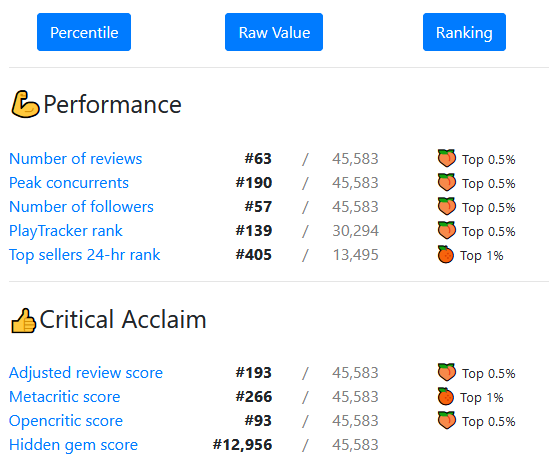
This is my approach to metrics. Instead of trying to take one figure and multiply it by some constant, I just gather as many independently verifiable public facts as I can and list them all together.
It's pretty clear just looking at this that Doom is a top 0.5% or top 1% game by any measure. However...
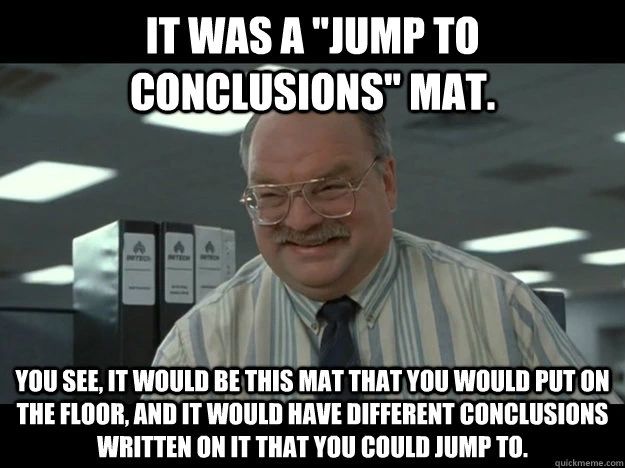
The trick is, any single metric is biased in a particular way. "Number of reviews" only measures highly engaged users (the kind who leave reviews), and is sensitive to changes in Steam's review system (with inflection points at November 26, 2013 and October 30, 2019). "Peak concurrent users" undercounts purchased but unplayed games sitting in people's backlogs, and probably overcounts multiplayer games. "Top sellers 24-hour rank" is the closest direct measure of sales performance we have, but it can't tell you anything about a game's performance in the deep past. And so on and so forth.
You see, if I was trying to extrapolate a "true" underlying sales figure from any individual metric alone, I not only have to contend with these distortions, but also issues of sample size. For lower selling games, for instance, a few extra reviews on the margin can have an enormous swing in the number of total reviews:
# Reviews | Relative power of +10 Reviews |
|---|---|
10 | +100% |
100 | +10% |
1,000 | +1% |
10,000 | +0.1% |
And this is before you even consider the fact that the most popular estimation method used to extrapolate sales from reviews has an enormous base uncertainty range, and even then we can't be entirely sure the relationship between number of reviews and game sales holds for every game on Steam.
The whole point of having metrics is to be able to compare games to one another on an apples-to-apples basis – and you lose that firm baseline when you start multiplying figures together and sticking dollar signs in front of them.
Bottom line:
We can learn a lot more from data we've actually got than from pining after figures we don't have.
Data isn't enough though, you also need context, and that's what these three little buttons are for:

Each of these is a different way of looking at the same information. "Ranking" is the default, but here's what "Raw value" shows:
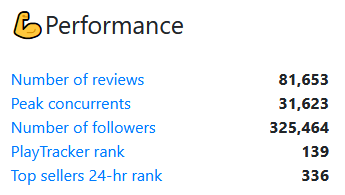
I'm not estimating or guessing anything here. I can display these metrics with high confidence and incredibly precision because they're all public figures that I can just measure directly. But what do they mean? Well, let's see if we can tell an (honest) story.
Here's the percentiles:
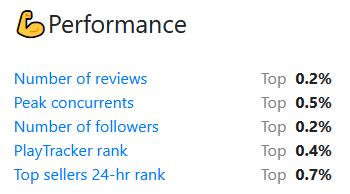
And here's the rankings:
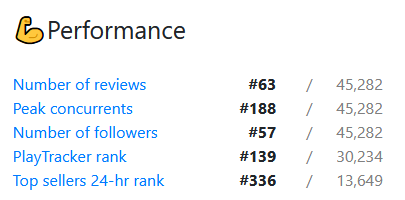
And why not throw in a column of with tasty fruit icons that presents percentiles as "tiers" to help my brain visually process the context just that much faster:
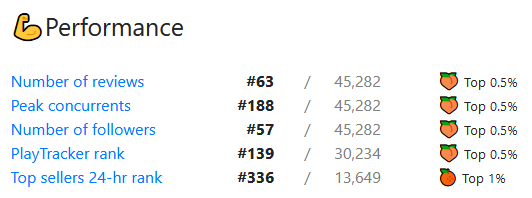
This starts to paint a picture. I don't know how many sales DOOM (2016) has sold and neither do you. But I know it's probably in the top performing 100-200 games on Steam by any reasonable measure. Heck, it's a 4 year old game and it's still managed to hit #336 on the top sellers chart in a recent day.
Okay, so we can get some basic metrics. What else can we do?
Well, we can see how well any given game performs within a specific category:
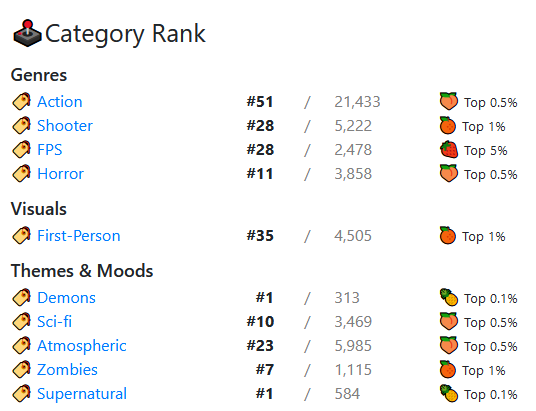
This shows us how DOOM performs relative to other games it shares tags with. Not surprisingly, it's near the top of just about every category it's in, only dropping out of the top 1% when you pit it against literally every other FPS on Steam.
Now, let's look at some other games' category ranks, specifically two games at the top of their respective genres.
Tales of Maj'Eyal, is the #2 Traditional Roguelike on all of Steam:
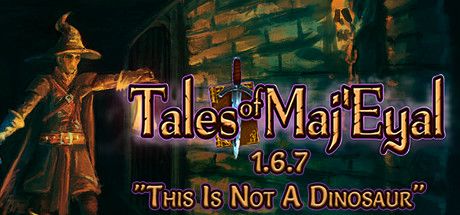
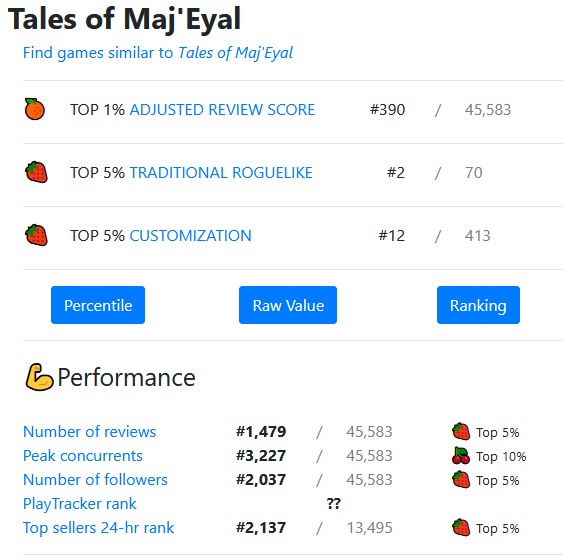
And here's Dead Cells, the #1 Roguevania on Steam.
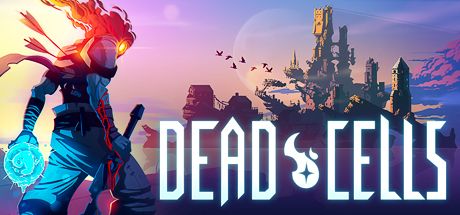
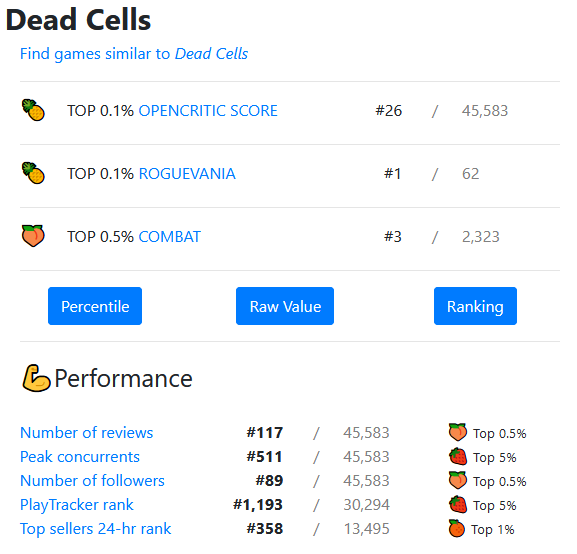
Both of these are fairly niche genres in terms of number of titles, having only about 60-70 titles on Steam each, but they're very different in terms of overall popularity.
Tales of Maj'Eyal has good stats for an indie game – more than most indies will ever achieve – but Dead Cells in on another level, cracking the coveted top 1% and even top 0.5% tiers of all games on Steam.
What can we conclude from this story?
Well, it's obvious that the Roguevania genre (and it's parent genre, the Action Roguelike) is more popular than the Traditional Roguelike genre. But what does this mean for the average indie developer? Should they avoid making a Traditional Roguelike and go for making a Roguevania or Action Roguelike instead?
That's not as clear. Although the Roguevania genre is more popular and you might read that as having a higher potential sales ceiling, you'd also be setting yourself up to compete against some of the most popular games on all of Steam. So should you make a Traditional Roguelike, hoping to compete in a smaller pond? Well, maybe.
I think that's the wrong question to ask. Let's be real – most indie devs already have a good idea of what kind of games they want to and are able to make, and picking some random genre that your heart really isn't into, simply on the basis of sabermetrics, is a recipe for failure. What I do think is important is going in with your eyes open.
So, let's say you've already decided to make a Traditional Roguelike. Do you need to unseat the genre king to achieve success? And if so, do you have what it takes to do it?
Well, when I started writing this article, Tales of Maj'Eyal was actually #1 in its category. So "who will be the next genre king" is no longer a hypothetical question.
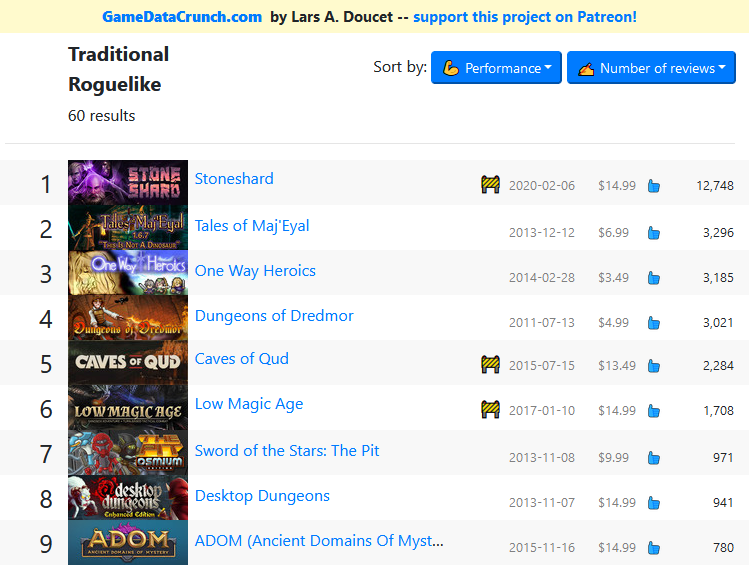
The new King of the Traditional Roguelike Genre is the Early Access title Stoneshard. I don't know a whole lot about this title, but it's blasted the roof off of this genre's low ceiling. By various metrics it's done anywhere from four to twenty times better than the next best performing Traditional Roguelike.
If I was working in this genre I would want to dig deeply into this story. Has Stoneshard been around for a long time and only recently updated its tags? Did it suddenly catch a lot of attention from streamers? Did it have a big crowdfunding push? Was it successful on some other platform first and only recently launched on Steam? And so on. (Ideally, GameDataCrunch would eventually be able to supply all the information needed to puzzle this out)
But there's a whole lot more you can do with GameDataCrunch.com than just look at performance metrics. A recent new feature is a "similar games" view as well as audience overlap measurements. Let's say I want to find games Similar to Dead Cells:
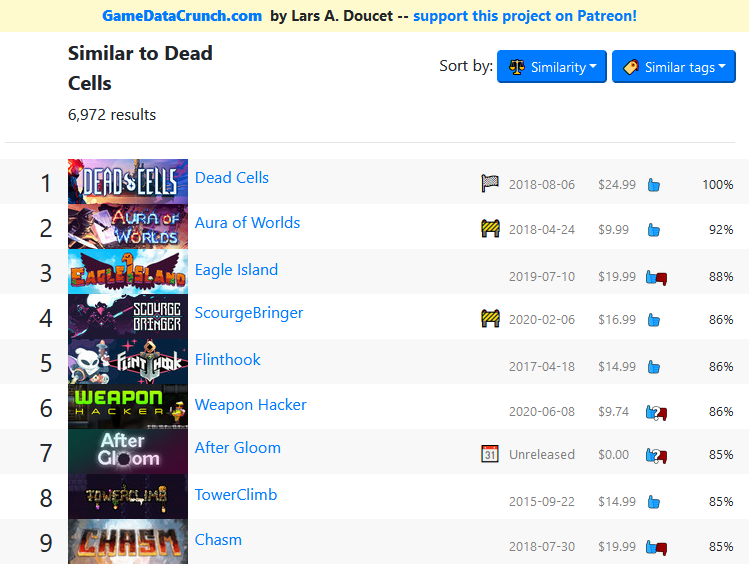
This view is basically Steam Diving Bell 2.0, although it might still have some bugs to work out. You'll notice you have multiple ways to judge "similarity". The default is a similar tags algorithm, heavily biased toward genre, subgenre, visual properties such as dimension and art style, game features, theme, and mood (in roughly that order).
But you can also look at "similar games" that have a lot of players in common (currently measured as # of people who have reviewed both games):
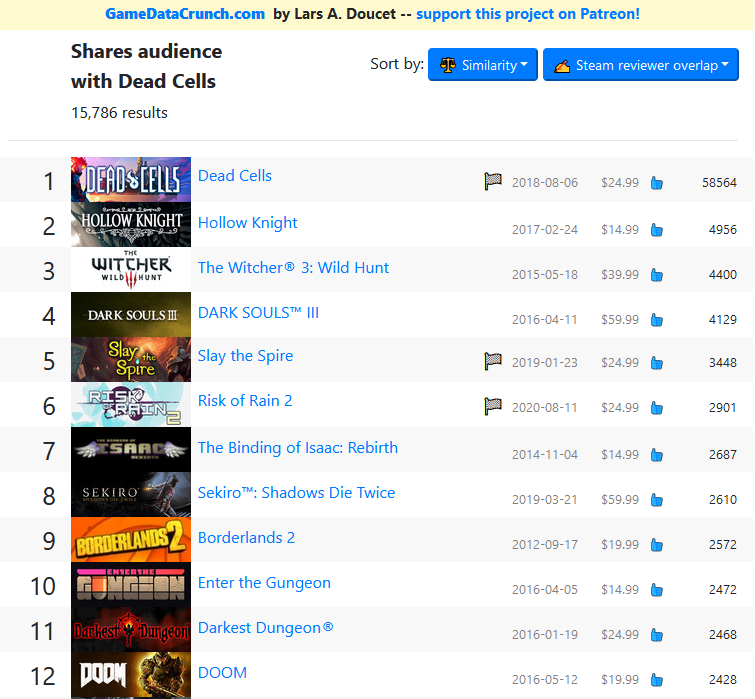
Unsurprisingly, the greatest overlaps tend to be between massively popular games that basically everybody on Steam owns. So straight out of this box this figure isn't super useful. That's why I have a third measure that blends it with tag similarity:
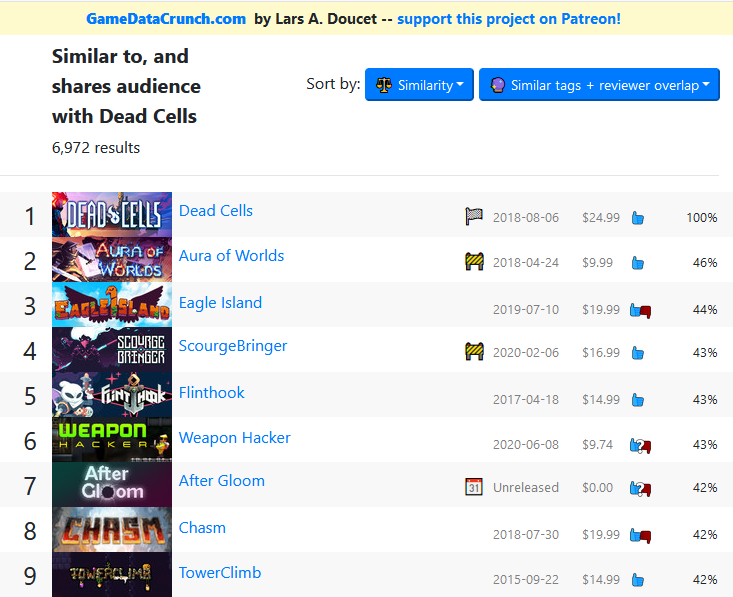
This will show you games that are both semantically similar in terms of tags and have some degree of audience overlap. I find that this tends to provide the best matches for most games.
I built this website because I have a lot of opinions about how game analysis should be done – chiefly, I want to move the conversation away from speculation and closer to foundational evidence.
But it's not just about the data. It's about the questions we ask, and that has a lot to do with how we present the data.
One way to improve presentation is to make it easier to look at games within specific categories, and to do that you need a good taxonomy, and I have a lot of plans for improving the way we classify games. For instance, I store two tag tables in my database – one that's slurped from Steam's public information directly, and the other that applies overlays and corrections on top of it, which is what I actually use to drive all the site's queries. Right now I haven't done much besides apply Query Expansion to everything in the second table, but I'm also working on adding a growing list of novel genres and tags that aren't available on Steam. And dammit, Persona 4 needs the "Life Sim" tag and I'll be adding manual corrections like that here and there. (It's my website, fight me).
I hope that this website will be of use to developers, researchers, and data analysts, but it will also serve as a handy backend for my own purposes, building novel applications and experiments, the kind I used to work on back at Steam Labs.
I also intend to unify the catalogs of every major PC and console game store, such as the Epic Games Store and the Nintendo Switch.
If you want to know more, please check out www.gamedatacrunch.com!
If you want to follow along, there's a newsletter signup on the main site at the link above. And we have a patreon if you want to support the project.
Read more about:
Featured BlogsYou May Also Like